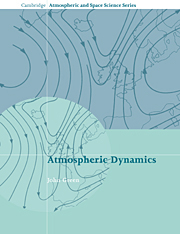Book contents
- Frontmatter
- Contents
- Introduction
- Chapter 1 Description of atmospheric motion systems
- Chapter 2 Notation
- Chapter 3 Fundamental equations
- Chapter 4 Nearly horizontal atmosphere
- Chapter 5 Gravity waves
- Chapter 6 Shearing instability
- Chapter 7 Vertical convection
- Chapter 8 Mesoscale motion
- Chapter 9 Motion of large scale
- Chapter 10 The forecast problem
- Chapter 11 Motion in a barotropic atmosphere
- Chapter 12 Modelling
- Chapter 13 Models
- Chapter 14 Transport and mixing
- Chapter 15 General circulation
- Appendix
- Index
Chapter 8 - Mesoscale motion
Published online by Cambridge University Press: 17 September 2009
- Frontmatter
- Contents
- Introduction
- Chapter 1 Description of atmospheric motion systems
- Chapter 2 Notation
- Chapter 3 Fundamental equations
- Chapter 4 Nearly horizontal atmosphere
- Chapter 5 Gravity waves
- Chapter 6 Shearing instability
- Chapter 7 Vertical convection
- Chapter 8 Mesoscale motion
- Chapter 9 Motion of large scale
- Chapter 10 The forecast problem
- Chapter 11 Motion in a barotropic atmosphere
- Chapter 12 Modelling
- Chapter 13 Models
- Chapter 14 Transport and mixing
- Chapter 15 General circulation
- Appendix
- Index
Summary
Definition of mesoscale
There is no universally accepted definition of mesoscale. Here we use it to denote motion that is not dominated by the mechanics of gravity waves, nor by the near geostrophy of Chapter 9, but is aware of, and compromises between, both. We have in mind the motion in frontal zones, the organisation of several cumulonimbus to make a severe storm, squall line, or even a hurricane, and the longer-term evolution of sea breezes. Sometimes the word mesoscale is used to indicate motion whose scale is of order 100 km but this geometrical definition includes a number of distinctly different physical processes. For example, motion on the scale of 100 km in the ocean is very similar in mechanism to the scale of 1000 km in the troposphere in that baroclinity, static stability, and variation of Coriolis parameter with latitude play similar roles. We prefer to use a criterion based on the dominant physical processes rather than on the geometry. There are disadvantages, and we find that the meridional overturning, of global scale, comes within our new definition of mesoscale, which is at first sight astonishing. There is often no very obvious energy source for mesoscale motion defined this way. Rather the effect is to organise the energy already available.
- Type
- Chapter
- Information
- Atmospheric Dynamics , pp. 104 - 116Publisher: Cambridge University PressPrint publication year: 1999

